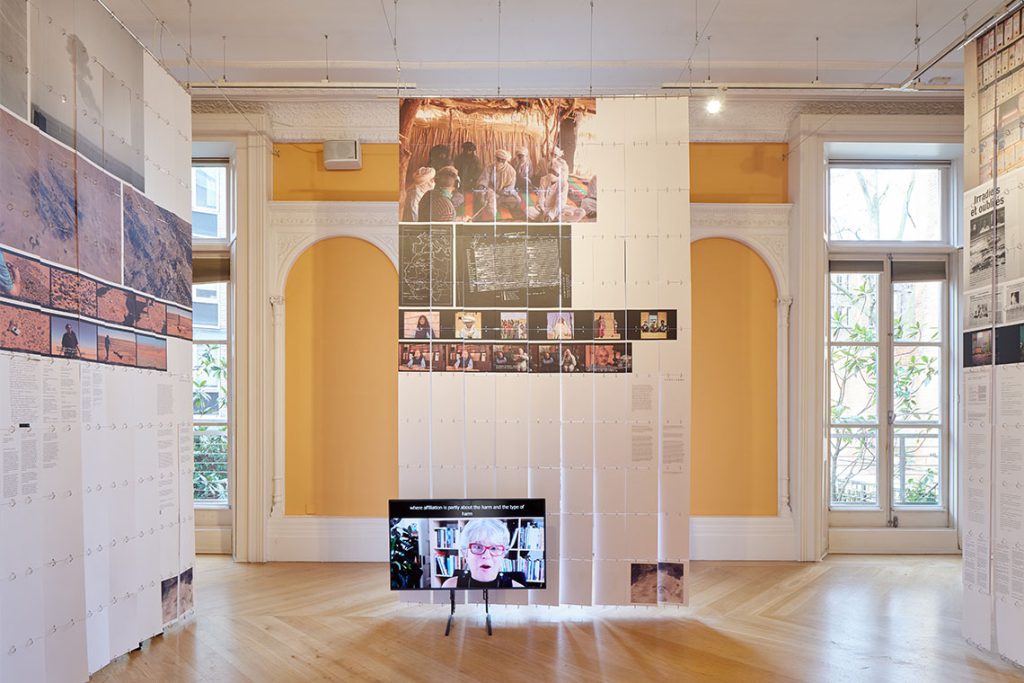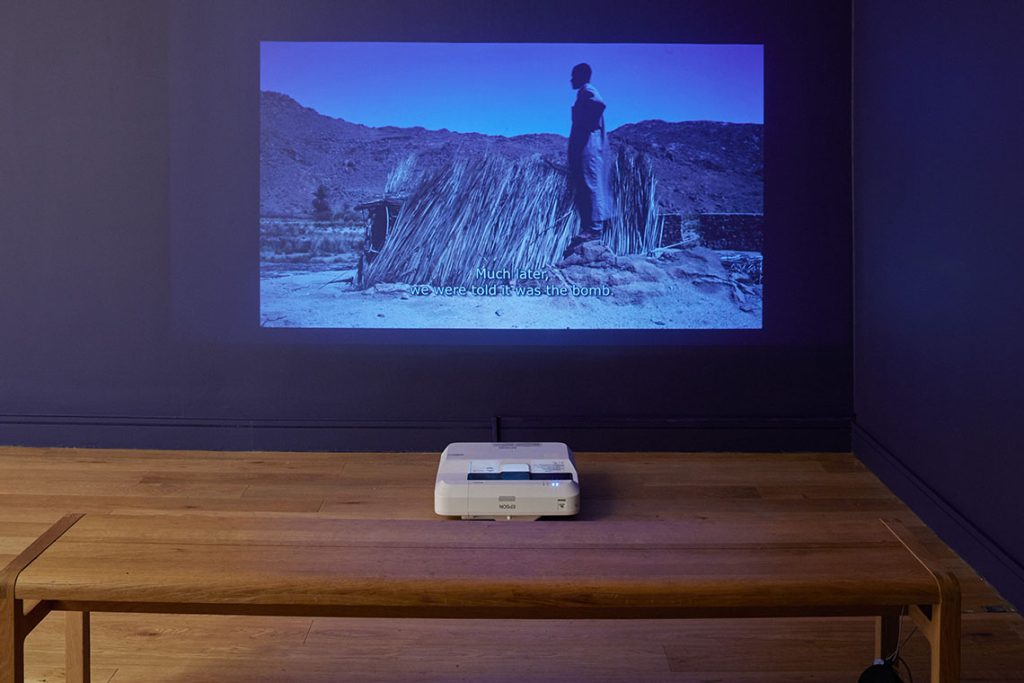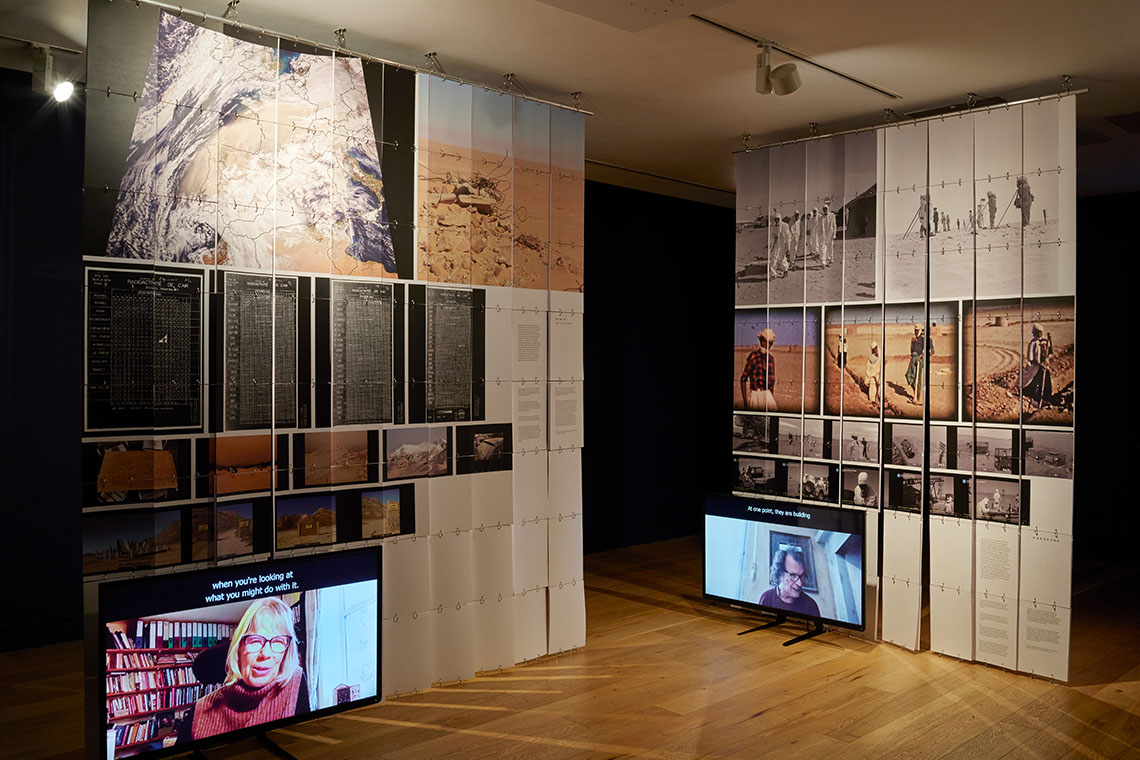In Performing Colonial Toxicity, her current solo show at London’s Mosaic Rooms, Samia Henni unpicks France’s brutal nuclear adventures in Algeria and lays bare the enduring legacy.
Printed sheets of paper intricately bound together line the Mosaic Rooms’ galleries, towering over the viewer as they wander through silent videos and faded topographical renderings of a vague desert landscape. The walls are painted a dark, sandy yellow – an aberration from the Mosaic Rooms’ usual light and airy feel.
The palpable change in the gallery’s ecosystem can be attributed to its latest exhibition, Performing Colonial Toxicity, by Samia Henni. An architectural historian, exhibition maker and educator, Henni has been studying and theorising desert landscapes through lenses of colonialism, architecture, resource extraction, warfare and forced displacement for years. Her latest edited volume, Deserts Are Not Empty (2022), brings together a plethora of pieces that aim to hypothesize and imagine deserts beyond empty spaces ripe for colonisation, extraction, and occupation.
Performing Colonial Toxicity is part of a larger research project undertaken by Henni that seeks to scrutinise nuclear tests and detonation in the Algerian Sahara conducted by French colonial powers. During the Algerian Revolution, France operated a secret nuclear programme in the Algerian Sahara that resulted in the toxification of the Sahara and spread radioactive fallout across Algeria as well as parts of North, Central and West Africa, as well as the Mediterranean.

Henni’s research project includes the book Colonial Toxicity: Rehearsing French Nuclear Architecture and Landscape in the Sahara and an open access digital database titled The Testimony Translation Project. Taken together, this three-pronged approach to unearthing the contaminated, nuclear archive presses for a widening of access to this resource – to this day, most of the French nuclear archives remain classified. Henni presses for their opening, which she sees as crucial for exposing the pasts, presents and futures of colonial toxicity in the Sahara.
The exhibition at the Mosaic Rooms presents a small sample of Henni’s own larger immersive, multimedia archive, pieced together from available, contraband and leaked materials from the still-closed nuclear archive. A ‘performative archive’, Performing Colonial Toxicity, invites the viewer to directly confront France’s nuclear past through mixed text, imagery and maps spread throughout the galleries. Whether it be screenshots of videos, handwritten letters from high-ranking French generals or diaries from survivors of the four atmospheric atomic bombs and 13 underground nuclear bombs France that detonated during 1960–66, the vertically-presented material directly confronts the viewer. Quite literally, one cannot move freely around the space — sheets of paper bound together by binder rings create walls in the otherwise open gallery, requiring full circumambulation to piece together the complex story of toxicity and colonialism.
Embedded within the first room’s paper walls are silent videos complementing the printed material, adding an additional layer to understanding the deep environmental and psychic trauma that Henni’s research illustrates. Interviews with scholars and screen recordings of mapping software make up most of these videos, the latter attempting to map out the exact areas of radioactive and nuclear destruction undertaken over the six years of the French nuclear exercises, and continuing today with contaminated earth and generational trauma passed down from survivors.

In the downstairs gallery, Henni brings attention to survivor testimonies through oral histories and further printed archival evidence. One video is particularly alluring: an excerpt from the 2008 documentary Vent de sable, le Sahara des essais nucléaires (Sandstorm, the Sahara of Nuclear Tests), written and directed by Larbi Benchiha and produced by 24images. Following Bruno Barrillot, co-founder of Observatoire des armements in Lyon, the film documents his methodical scientific study of radioactive material and remnants in the Algerian Sahara. Barrillot explains the health implications of these nuclear tests, including the cancerous risk embedded within certain parts of the desert, notably stones and rocks nearest to the blast sites.
The other side of the gallery plays an excerpt from the 2013 film AT(h)OME, directed by Élisabeth Leuvrey. While Benchiha’s film examined the scientific legacy of French nuclear tests, Leuvrey interviews survivors and victims through very emotional, gut-wrenching portrait photographs, filmed sequences and victim voiceovers. Approximately 15 minutes into the film, viewers watch and listen to the Beryl bomb on the village of Mertoutek. Tears and sniffles filled the space on its opening night as viewers were confronted with the highly charged film. Bringing life to the static archive – and the buried toxic nuclear waste France continually attempts to hide – the downstairs gallery puts faces to France’s nuclear tests, still considered a secret défense, or top-secret military subject.
Henni’s Performing Colonial Toxicity unearths Algerian Sahara’s nuclear history, a history well known to survivors, victims and French civic and military institutions. With this history remaining locked and hidden by design, Henni presents a damning alternative archive that layers colonial history with environmental and human destruction. As Henni writes in Deserts Are Not Empty, “the institutional obstruction of history-writing and the denial of social and environmental justice are embedded in France’s coloniality and toxicity, as well as in its attempts at delaying and unsettling the ‘horizon of imaginable time’: the imaginable time and temporality of the medical care of the victims, the decontamination of the sites, and detoxification of the radioactive materials and infrastructure left on site, and the cleaning of the undergrounds and overgrounds of the desert”.



